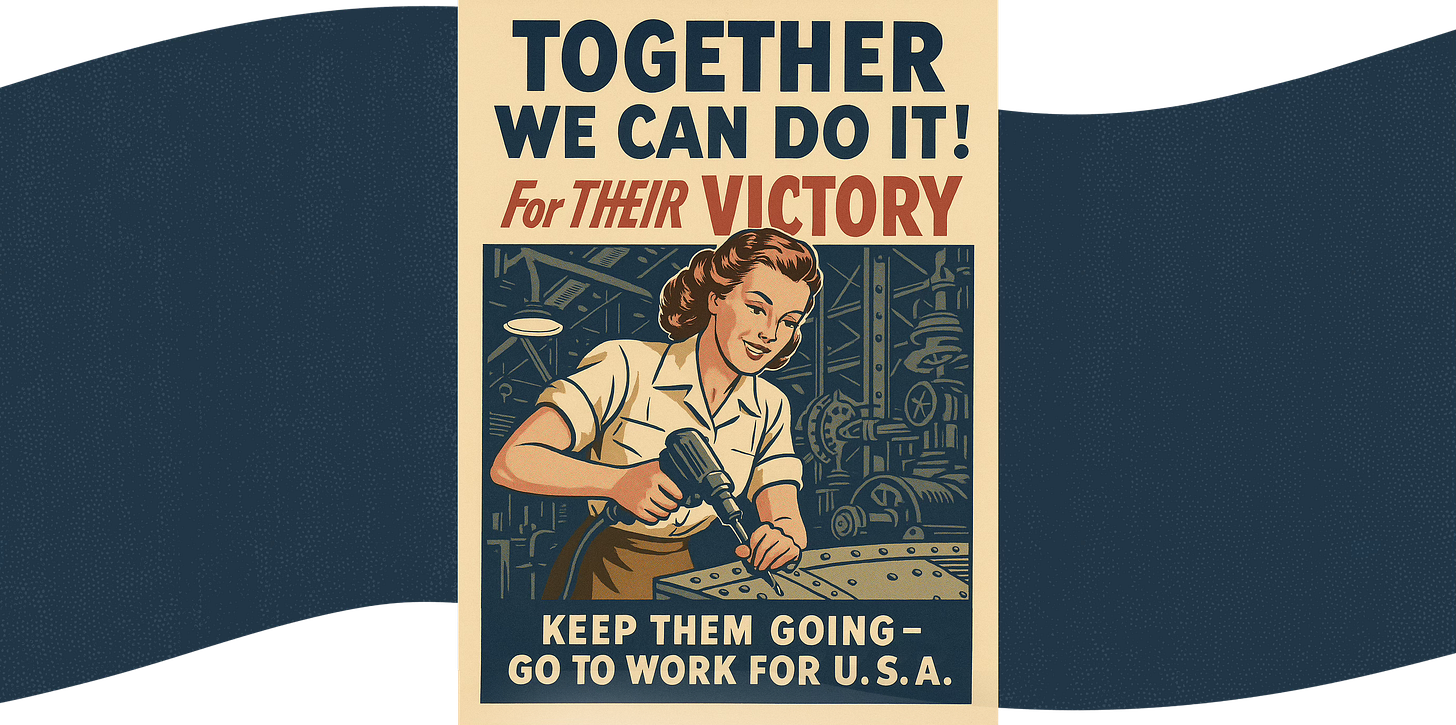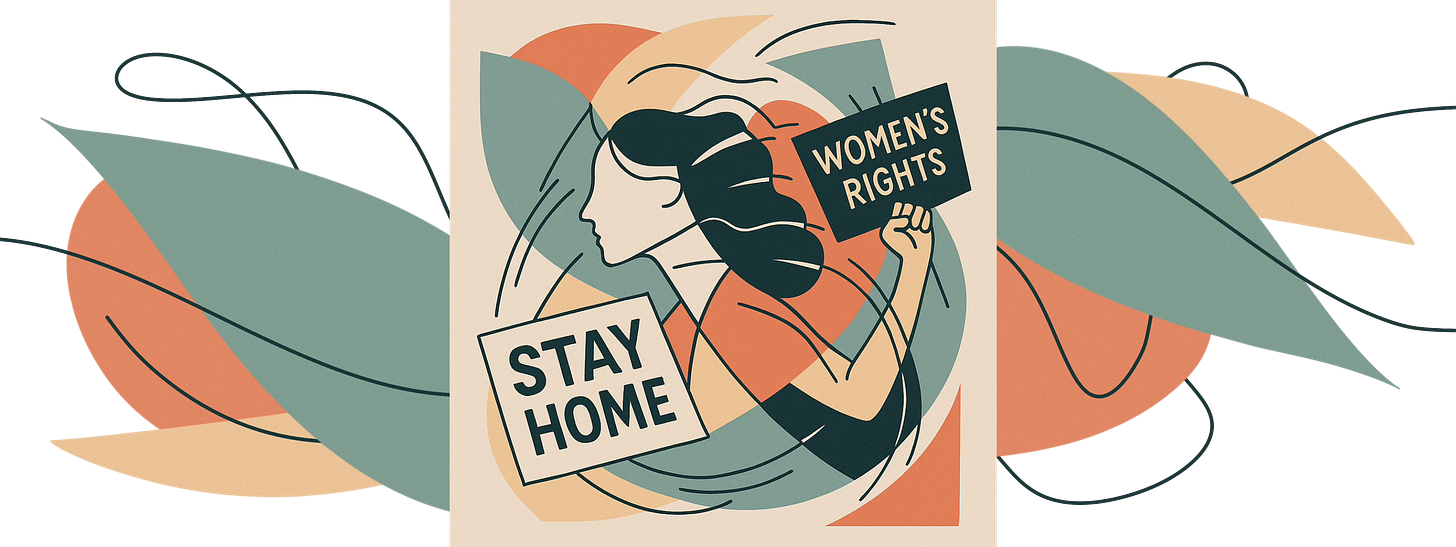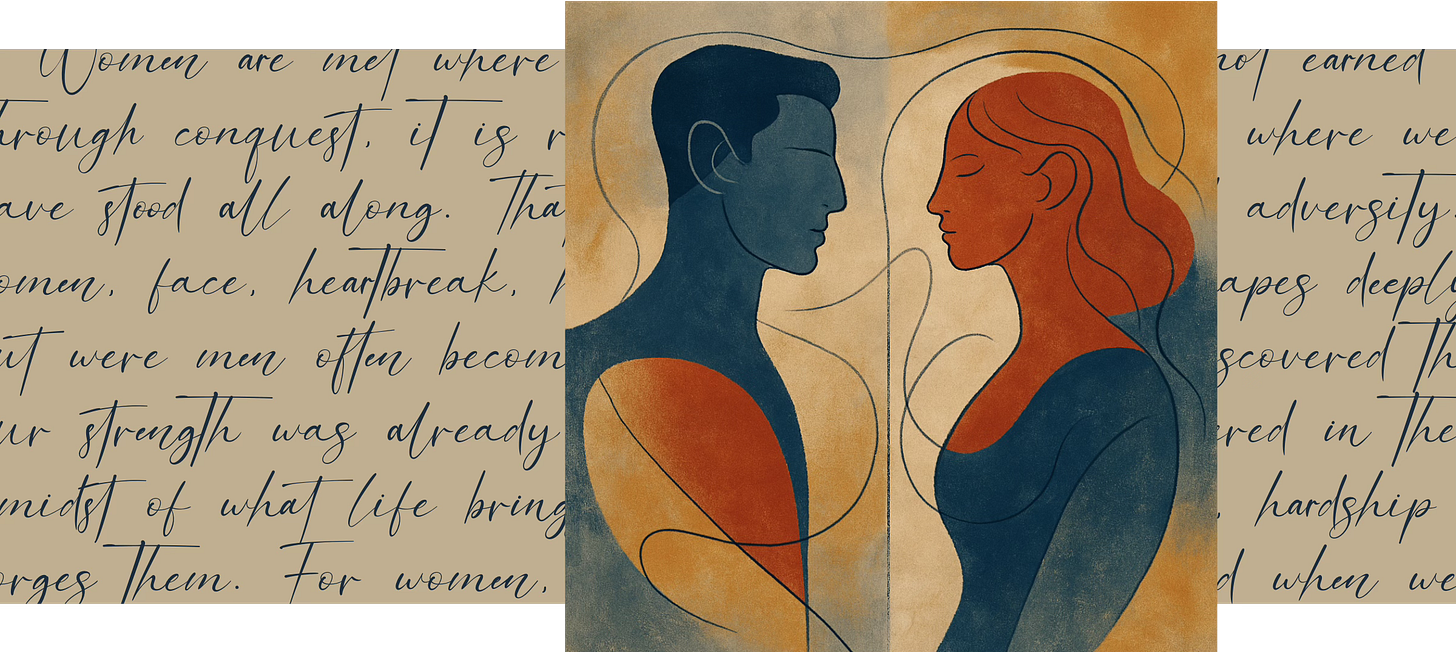The Quiet Rebellion
Finding Unity in a World That Pulled Us Apart
In a world spinning faster day by day, where headlines shout and daily demands pull us in each direction, what if the quietest thing you could do was the most radical?
This is not a call to abandon your career. It’s not some demand to return to a romanticized past where women only served at the hearth. It’s an invitation to find peace in creating, refining and sharing the works of your own hands. Whether your days are filled with boardroom meetings or bedtime stories, there is room for less noise and more meaning.
There is room for a quiet rebellion.
How We Got Here: The Fracturing of Femininity
Post War Convenience
The story of how women’s roles shifted in America isn’t simple. It’s layered with necessity, industry and carefully crafted persuasion.
During both world wars, women stepped into the workforce to fill national needs, taking on the roles traditionally held by men.
But something else was happening behind the scenes: food sciences were taking massive leaps forward. Industrialized food systems ramped up to feed our soldiers new shelf stable "just add water" products. What began as a necessity of war became peacetime opportunity.
As the wars ended, manufacturers were left with these factories capable of churning out huge quantities of highly processed foods meant for the soldiers that were now returning home. All of this lead to an opportunity for economic growth, encouraging every industry to expand its markets. The war was over but the production lines (and the hunger for profit) remained.
The answer? Turn wartime rations into cultural conveniences.
Cake mixes, for example, were a direct result of this peacetime shift. The science behind dry mixes was developed to provide quick, reliable nourishment for soldiers. Postwar, these mixes were rebranded and reformulated for the American palate. But homemakers didn’t immediately take the bait. Many didn’t trust them, but for most, these products felt like cheating or that they were too easy to be real cooking.
Sensing this hesitation, the Ad Men of the 1950s launched their own battle, a war on the hearts (and wallets) of American women, the primary household consumers. They sold a vision: convenience as liberation. Scratch cooking became "drudgery" and processed foods were marketed as modern and essential for the busy woman who deserved a break.
The Science of Desire & Perception
Enter Edward Bernays — the man known as the father of modern public relations and advertising and the nephew of Sigmund Freud. Born in 1891 and living until 1995 (103 years old!), Bernays pioneered the way modern marketing would manipulate human thought.
He didn’t simply sell products. He sold ideas. He took Uncle Freud’s theories of the subconscious (desires, fears, insecurities) and applied them to mass persuasion. In his mind, people weren’t thoughtful individuals; they were the lowly masses, easily swayed by crafted images and words.
Bernays was unapologetically elitist. He believed a select few should guide the many. And guide them he did; whether convincing women to smoke cigarettes in the 1920s as a symbol of liberation, or later, painting homemaking as both duty and limitation in the 1950s.
He quite literally wrote the book on persuasion. His 1928 work, Propaganda, laid out THE blueprint for controlling public opinion. In his words:
"The conscious and intelligent manipulation of the organized habits and opinions of the masses is an important element in democratic society."
I don’t know about you, but to me, that doesn’t sound much like democracy.
Bernays’ legacy is deception. Not truth. Not empowerment. Just control. Calculated and quiet enough that most never knew it was happening, let alone who was pulling the strings.
During the wars, we women were needed: vital to the factories, to production, to the nation’s future. But when the war ended, we were told to go home, bake a cake, and find purpose in simpler things, never mind that those "simpler things" were often just processed goods they needed us to buy.
As the economy faltered and government officials saw a loss of tax dollars from women leaving the workforce, we were told once more to return to work. But this time, it wasn’t for patriotism. It was for profit, yet this time, it was wrapped up in words like "empowerment" and "progress".
It’s no wonder the 1960s exploded with rebellion and confusion.
The first wave of feminism had secured the vote in 1920, a fight for legal rights. But the second wave? It had teeth. It was born out of whiplash, being pushed and pulled, told to stay home, then told to leave it.
Somewhere along the way, the messages got twisted:
To have worth, you had to leave home.
To matter, you had to conquer, climb, outdo and do it all.
Economic Shuffling
During all this cultural shift, the economy was slowly reshaping the American household. The postwar idealists painted a picture of women joyfully returning home, leaving those factories and offices behind so men could reclaim their jobs. The reality was more complicated. The factories couldn’t return to pre war output, the economy wouldn’t stop growing and the government’s hunger for tax revenue increased. The war had paved the road for expanded production, employment and consumption. And women—whether they knew it or not, were at the center of it.
The tax code evolved slowly over time. For a while, the family wage was still upheld as the ideal: one breadwinner, one homemaker — but behind closed doors there were subtle shifts occurring that would encourage both spouses to go out and work and pay up those taxes. You know, for empowerment.
Summary of the tax timeline:
1945-1947 | Send the women home, restore men’s jobs, go back to normal.
1948-1950 | First blips that typical nuclear family wages couldn’t sustain the overpromised postwar economy.
1950-1960 | Quietly accepting women into the workplace after realizing a larger working population was necessary for consistency during the Korean War and the arms race with the USSR.
1960’s-onward | Open acknowledgement of two income households with the tax incentives to match.
During the tax shuffle in the 1960s, the feminist movement was finding a stronger voice. Some voices called for respect and dignity across all roles fighting mainly for the right to choose. Others cried for women to leave home entirely in pursuit of “worth” and further equality.
Like any human movement, it was mixed. There were wise feminists and foolish ones, just as there have always been wise and foolish homemakers. Both sides had voices and ideas worth hearing, but there was also plenty of noise worth ignoring. During this time, the “sides” and messages got blurred.
Instead of asking what our feminine strength could offer the world, we started adapting so we could conquer like men. We picked up their swords, their strategies, their pace. And yes, it worked, we rose. But at what cost?
What if our greatest strength as women isn’t in conquering, but in protecting?
What if our power isn’t in mimicking men’s battles, but in fighting our own with tools perfectly fitted to our hands? No less powerful, just different.
Different by Design
Men and women were never meant to be perfect mirrors of each other. We were meant to be counterparts, each one possessing different innate talents and working together in harmony. We don’t need to duplicate one another’s calling to be equal in worth.
Men are shaped through the struggle. They become who they are meant to be by striving. History and literature are full of men who are forged by hardship, honed by battle and strengthened by the climb to the top as well as the fall to the bottom.
They are called outward, to take the hill, win the prize, conquer!
But women?
Women are met where they live. Our strength is not earned through conquest, it’s revealed in the places we have stood all along.
This doesn’t mean we are spared adversity. Women face heartbreak, hardship and trials that shape us deeply. But where men often become through the climb, we discover that our strength was already there, waiting to be uncovered in the midst of what life brings to our doorstep.
For men, hardship forges them. For women, hardship unveils them.
And when we fight, we fight for something. Women rise up when something they love is threatened.
A man goes out to hunt for his prize.
A woman rises to protect what is cherished.
In protection, there is courage.
In nurturing, there is strength.
In creating, there is legacy.
You don’t need to fight like a man to be powerful. When we abandon our own strength to take up a man’s weapons, it is our hearts that suffer the most. Instead, fight your battles your way. With grace. With fierce gentleness. With a steady power that leaves the world baffled.
Our differences are not flaws to be fixed.
They are God given gifts to be honored.
Kinship Across the Spectrum
In this modern age, no matter where you lead, as head of a company or at the heart of your home, there is power in your role.
There are always those who will argue the right way to be a woman. Some will insist we belong in the home. Others will argue we belong in the workplace. But the truth is, the world has changed. We have choices now.
With these choices we now carry a responsibility… an honor, really: to grant one another grace.
To respect where our stories have taken us.
To listen carefully for where we are being called.
I am constantly inspired and amazed by women who run companies, fund charities, innovate in the marketplace, or create on a global scale. Women like Joanna Gaines, Jonna Jinton, Erin French, Barbara Corcoran, Lori Greiner and Ann Voskamp all embody leadership, creativity and grace, but each in their own distinct, feminine way. They don’t lead like men. They lead like women, and that is what makes their work so powerful.
Likewise, there is beauty in the women who shape futures in their homes — raising children, creating beauty, tending the homestead, or standing as the quiet strength behind their husband’s calling. These women don’t lead any less and their influence runs just as deep.
We all serve in different spaces.
Here’s the truth. The working woman and the washer woman have more in common than society lets on. They both carry more than the world will ever see and keep going anyway.
They are equals, sharing their gifts in unique ways.
A Call to Remember
No matter where you stand today, you have the chance to reclaim something we traded away when our culture chose speed over substance and efficiency over effort.
Maybe for you, it’s baking that first loaf of bread from heritage grains. Perhaps it’s offering something handcrafted to a neighbor. It could be in tending your garden, writing words that heal or by being fully present for your children or spouse or friends.
The world has changed. We can’t undo that.
But we can move forward with intentionality.
That’s what this journal is about: expanding our horizons, rediscovering skills that once came naturally and reminding all of us that we were never meant to do this alone. Community is everything.
It won’t look the same for any of us.
Some will tend to their homes. Some will build businesses.
Some will hold the line in the small places that the world will never see.
However we live and wherever we live, the calling is the same:
To revive a quiet rebellion of presence, tenderness and strength.
Not working against one another. But alongside one another.
Because there is nothing wrong with being a homemaker.
And there is nothing wrong with being a CEO.
The question isn’t where you stand. It’s how you stand there.
Something to Share
No one can do life alone. However different our paths may look, we all need each other. That’s why I made these greeting cards for you to print and send.
Just download the file, set your printer to “scale to fit”, trim with a paper cutter and fold. That’s all you’ll need before sending one or two (or more!). This is just one way to remind someone that they aren’t walking alone.










